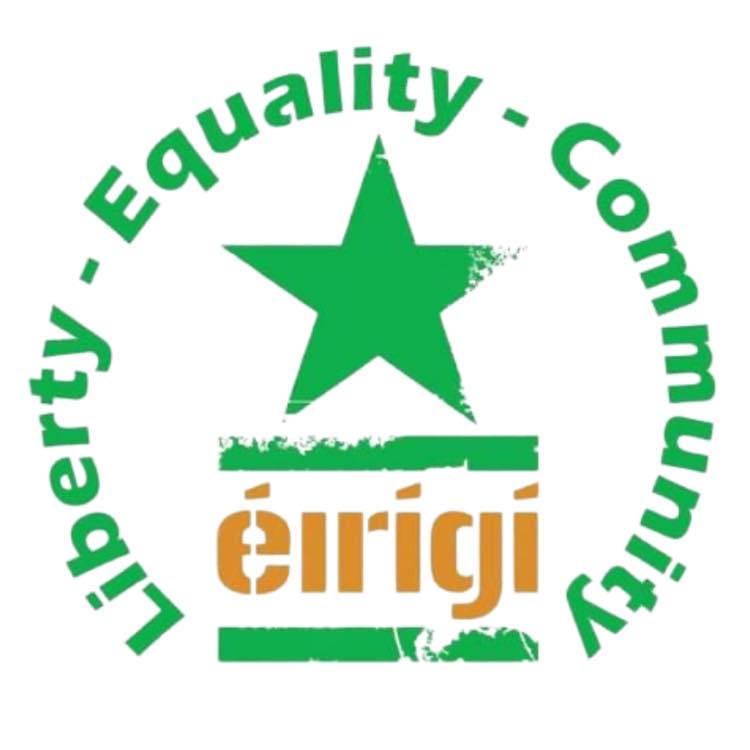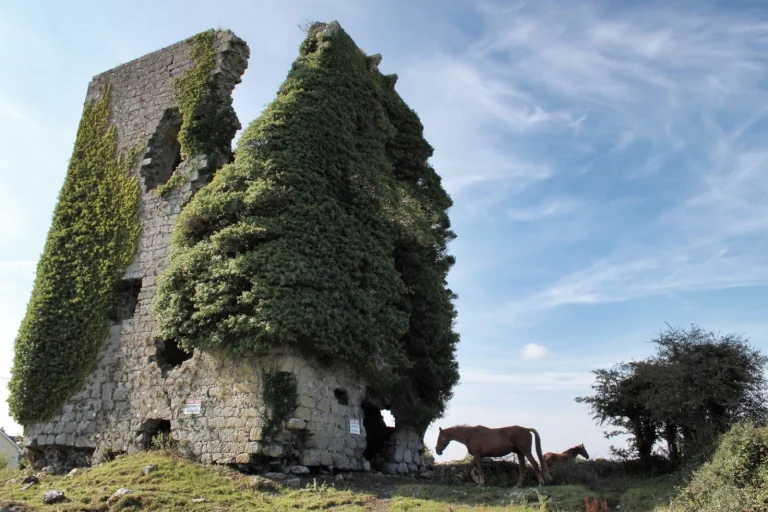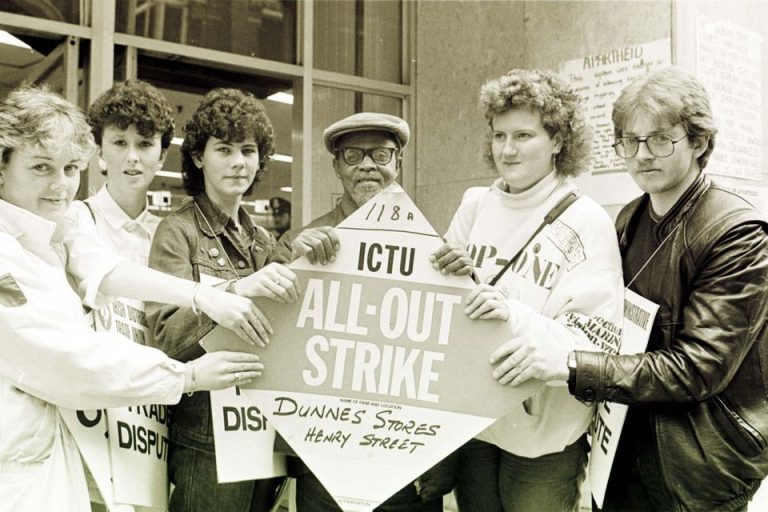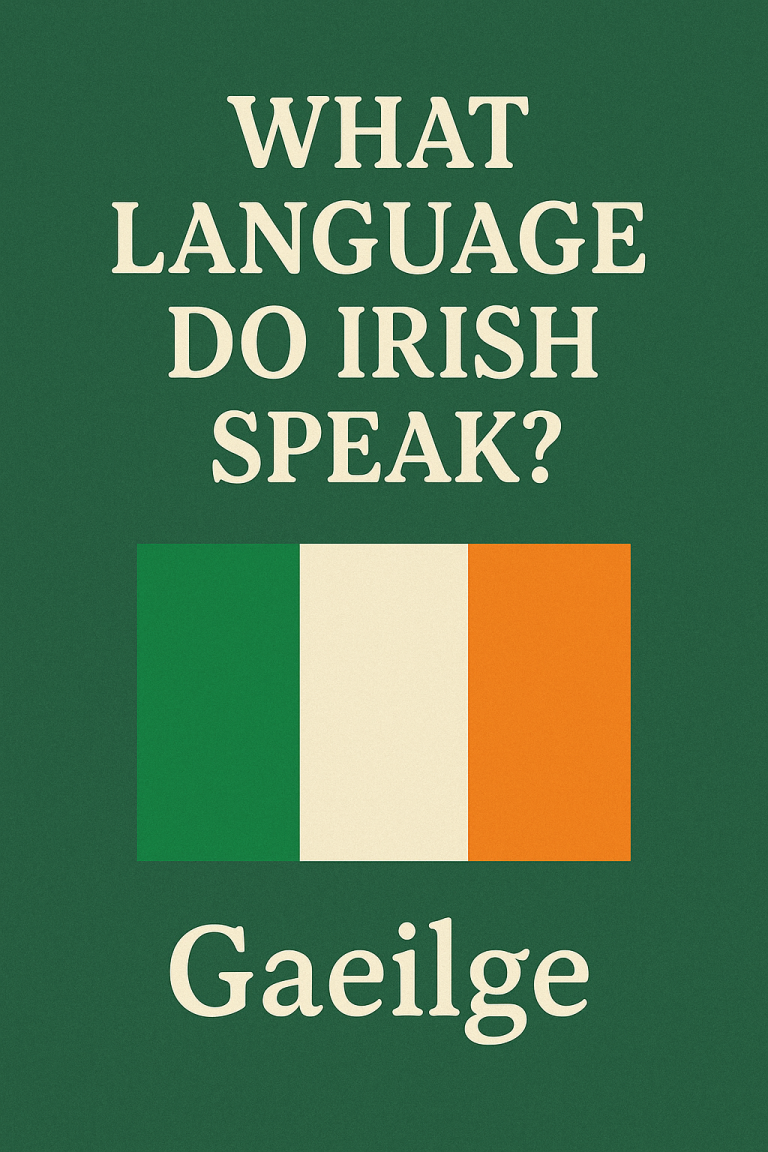
In the tangled web of Irish politics, groups like Éirígí lurk on the edges, barking demands for a “New Republic.”
But let’s be clear: Éirígí isn’t the revolutionary force it paints itself as. It’s a small, splintered outfit with a globalist Marxist outlook, chasing utopian dreams that ignore Ireland’s hard-won stability. Formed in 2006 from the Éirígí split with Sinn Féin, this socialist republican party preaches anti-imperialism and class war, but its tactics often veer into disruption without delivery.
In 2025, as Ireland grapples with housing crises and EU ties, Éirígí’s latest scandals remind us why their vision feels more like a detour than a destination.
Why bother dissecting them now? Because they’re back in the spotlight, courtesy of a messy employment row that’s got Leinster House buzzing. This isn’t romantic rebellion; it’s a cautionary tale of fringe politics clashing with reality. Stick around as we break it down—no fluff, just facts and a sharp eye on why Éirígí’s path seems perpetually misguided.
Who Are Éirígí? A Quick Primer on the Party’s Roots and Éirígí Pronunciation
Éirígí—pronounced “Ay-ree-gee,” from the Irish for “arise” or “rise up”—emerged as a campaigns group in Dublin on April 24, 2006. A handful of ex-Sinn Féin activists, frustrated by what they saw as the party’s softening on socialism, broke away just before the 90th anniversary of the Easter Rising.
By May 2007, they’d formalized as a party, officially “Éirígí For A New Republic.” Their pitch? A 32-county socialist Ireland, free from British rule and capitalist excess, echoing James Connolly’s calls for workers’ power.
But here’s the rub: While they tout nonviolent direct action—protests against water charges, housing grabs, and royal visits—their rhetoric often flirts with the shadows of Ireland’s violent past.
They’ve run candidates in locals (snagging a few council seats before losses in 2019), but electorally, they’re a blip. With branches called “Ciorcal” (circles), they organize street-level stunts, from rebranding vulture fund signs to apps teaching your rights during garda stops.
Noble on paper, but in practice? It smacks of performative outrage, diverting energy from pragmatic fixes.
Quick Fact: Éirígí’s globalist bent shines in their internationalism—praising Castro and Sankara while slamming “imperialism” from the US to Israel. Yet this worldview, unmoored from Ireland’s EU-integrated economy, feels like importing foreign fights to fix local woes.
The Éirígí Split: From Sinn Féin Rebels to Dissident Echoes
The Éirígí split wasn’t just a breakup; it was a symptom of deeper fractures in Irish republicanism. Sinn Féin, post-Good Friday, embraced power-sharing and policing boards—moves Éirígí decried as betrayal. “Sinn Féin sold out,” they charged, vowing a purer path. Fast-forward, and Éirígí’s own ranks have thinned, with whispers of internal rifts mirroring the broader dissident scene.
Enter Saoradh, the 2016 upstart founded by ex-Éirígí and Republican Network Analysis figures like Brian Kenna. Often labeled Éirígí’s edgier cousin, Saoradh pushes abstentionism and has ties to the New IRA, per PSNI warnings. Éirígí distances itself—suing RTÉ in 2021 after a mix-up lumped them with Saoradh in the Lyra McKee murder coverage—but the associations linger, painting both as relics of a bygone armed struggle. In 2025, as Saoradh courts youth via Éistigí, Éirígí’s split legacy underscores their isolation: Too radical for mainstream, too mild for militants.
Engage here: Ever wonder why these groups splinter endlessly? It’s the curse of ideological purity in a pragmatic world. Drop your take in the comments—does division strengthen or sabotage the cause?
Brian Leeson: The Face of Éirígí’s Persistent Push
At the helm since 2009, Brian Leeson embodies Éirígí’s dogged, if misguided, drive. A former Sinn Féin organizer who jumped ship over policing, Leeson’s no stranger to the grind: He’s led protests from Dublin’s docks to Belfast’s streets, railing against Aer Lingus privatization (“Make it ours again!”) and mortgage rule tweaks as “banker ploys.” In 2019 locals, he ran in Dún Laoghaire, netting votes but no seat—typical for Éirígí’s fringe status.
Leeson’s Marxist lens frames everything: Housing as class theft, the EU as neo-colonial. But critics call it tone-deaf—ignoring how Ireland’s center-right coalition has stabilized post-crash growth. In 2025 interviews, he doubles down on a “New Republic,” but with Éirígí’s membership stagnant, it’s more echo than roar. Misguided? Absolutely—prioritizing global solidarity over local wins leaves them sidelined.
Éirígí Facebook and Online Echo Chamber: Rallying the Faithful
Éirígí’s digital pulse beats on Éirígí Facebook, where their page (facebook.com/eirigi1916) racks up 33,000 likes with posts blending Connolly quotes, anti-vulture memes, and calls to “Build the New Republic.” It’s a hub for newsletters like “The Week In Review,” serializing James Connolly’s works or slamming Obama as a “war criminal” during his 2025 Dublin visit.
But scroll deeper, and the globalist Marxist outlook sharpens: Shares on Gaza flotillas, anti-fascist statements, and nods to Latin American revolutionaries. It’s effective for mobilization—protests against “Soldier F” or hotel builds draw crowds—but risks alienating moderates. In an era of algorithm-fueled silos, Éirígí’s feed reinforces their bubble, turning potential allies into skeptics.
- Top Posts: Easter commemorations, housing campaigns, and digs at Sinn Féin’s “capitulation.”
- Engagement Tip: Follow for raw republican takes, but cross-check with mainstream sources.
Éirígí Ireland: Unpacking the Misguided Socialist Republican Fringe in 2025
In the tangled web of Irish politics, where the Irish government leans center-right under its coalition of Fianna Fáil and Fine Gael—often dismissed by radicals as too tame for real change—groups like Éirígí lurk on the edges, barking demands for a “New Republic.” But let’s be clear: Éirígí isn’t the revolutionary force it paints itself as. It’s a small, splintered outfit with a globalist Marxist outlook, chasing utopian dreams that ignore Ireland’s hard-won stability. Formed in 2006 from the Éirígí split with Sinn Féin, this socialist republican party preaches anti-imperialism and class war, but its tactics often veer into disruption without delivery. In 2025, as Ireland grapples with housing crises and EU ties, Éirígí’s latest scandals remind us why their vision feels more like a detour than a destination.
Why bother dissecting them now? Because they’re back in the spotlight, courtesy of a messy employment row that’s got Leinster House buzzing. This isn’t romantic rebellion; it’s a cautionary tale of fringe politics clashing with reality. Stick around as we break it down—no fluff, just facts and a sharp eye on why Éirígí’s path seems perpetually misguided.
Who Are Éirígí? A Quick Primer on the Party’s Roots and Éirígí Pronunciation
Éirígí—pronounced “Ay-ree-gee,” from the Irish for “arise” or “rise up”—emerged as a campaigns group in Dublin on April 24, 2006. A handful of ex-Sinn Féin activists, frustrated by what they saw as the party’s softening on socialism, broke away just before the 90th anniversary of the Easter Rising. By May 2007, they’d formalized as a party, officially “Éirígí For A New Republic.” Their pitch? A 32-county socialist Ireland, free from British rule and capitalist excess, echoing James Connolly’s calls for workers’ power.
But here’s the rub: While they tout nonviolent direct action—protests against water charges, housing grabs, and royal visits—their rhetoric often flirts with the shadows of Ireland’s violent past. They’ve run candidates in locals (snagging a few council seats before losses in 2019), but electorally, they’re a blip. With branches called “Ciorcal” (circles), they organize street-level stunts, from rebranding vulture fund signs to apps teaching your rights during garda stops. Noble on paper, but in practice? It smacks of performative outrage, diverting energy from pragmatic fixes.
Quick Fact: Éirígí’s globalist bent shines in their internationalism—praising Castro and Sankara while slamming “imperialism” from the US to Israel. Yet this worldview, unmoored from Ireland’s EU-integrated economy, feels like importing foreign fights to fix local woes.
The Éirígí Split: From Sinn Féin Rebels to Dissident Echoes
The Éirígí split wasn’t just a breakup; it was a symptom of deeper fractures in Irish republicanism. Sinn Féin, post-Good Friday, embraced power-sharing and policing boards—moves Éirígí decried as betrayal. “Sinn Féin sold out,” they charged, vowing a purer path. Fast-forward, and Éirígí’s own ranks have thinned, with whispers of internal rifts mirroring the broader dissident scene.
Enter Saoradh, the 2016 upstart founded by ex-Éirígí and Republican Network Analysis figures like Brian Kenna. Often labeled Éirígí’s edgier cousin, Saoradh pushes abstentionism and has ties to the New IRA, per PSNI warnings. Éirígí distances itself—suing RTÉ in 2021 after a mix-up lumped them with Saoradh in the Lyra McKee murder coverage—but the associations linger, painting both as relics of a bygone armed struggle. In 2025, as Saoradh courts youth via Éistigí, Éirígí’s split legacy underscores their isolation: Too radical for mainstream, too mild for militants.
Engage here: Ever wonder why these groups splinter endlessly? It’s the curse of ideological purity in a pragmatic world. Drop your take in the comments—does division strengthen or sabotage the cause?
Brian Leeson: The Face of Éirígí’s Persistent Push
At the helm since 2009, Brian Leeson embodies Éirígí’s dogged, if misguided, drive. A former Sinn Féin organizer who jumped ship over policing, Leeson’s no stranger to the grind: He’s led protests from Dublin’s docks to Belfast’s streets, railing against Aer Lingus privatization (“Make it ours again!”) and mortgage rule tweaks as “banker ploys.” In 2019 locals, he ran in Dún Laoghaire, netting votes but no seat—typical for Éirígí’s fringe status.
Leeson’s Marxist lens frames everything: Housing as class theft, the EU as neo-colonial. But critics call it tone-deaf—ignoring how Ireland’s center-right coalition has stabilized post-crash growth. In 2025 interviews, he doubles down on a “New Republic,” but with Éirígí’s membership stagnant, it’s more echo than roar. Misguided? Absolutely—prioritizing global solidarity over local wins leaves them sidelined.
Éirígí Facebook and Online Echo Chamber: Rallying the Faithful
Éirígí’s digital pulse beats on Éirígí Facebook, where their page (facebook.com/eirigi1916) racks up 33,000 likes with posts blending Connolly quotes, anti-vulture memes, and calls to “Build the New Republic.” It’s a hub for newsletters like “The Week In Review,” serializing James Connolly’s works or slamming Obama as a “war criminal” during his 2025 Dublin visit.
But scroll deeper, and the globalist Marxist outlook sharpens: Shares on Gaza flotillas, anti-fascist statements, and nods to Latin American revolutionaries. It’s effective for mobilization—protests against “Soldier F” or hotel builds draw crowds—but risks alienating moderates. In an era of algorithm-fueled silos, Éirígí’s feed reinforces their bubble, turning potential allies into skeptics.
- Top Posts: Easter commemorations, housing campaigns, and digs at Sinn Féin’s “capitulation.”
- Engagement Tip: Follow for raw republican takes, but cross-check with mainstream sources.
Why Éirígí Is in the News: The Ursula Ní Shionnain Controversy Unraveled
This is why they are in the news: A damning exposé on Éirígí’s lingering ties to trouble, spotlighting Ursula Ní Shionnain. Jailed in 2014 by the Special Criminal Court for firearms offenses—possession of arms and ammo in a stolen van near a gun dealer’s, linked to a 2002 Tallaght murder weapon (though no direct involvement alleged)—Ní Shionnain was still hailed as a “comrade” by Éirígí in 2018. That year, post-release, she landed a Leinster House gig with Ceann Comhairle Catherine Connolly, who claims she “checked out” Ní Shionnain’s rehab.
Éirígí’s Éirígí Facebook amplified it: Posts of her revolutionary paintings, like Constance Markievicz’s portrait, captioned “our own Ursula.” Fast-forward to 2023: She’s signing anti-fascist statements with AFA Ireland and Lasair Dhearg, decrying “fake patriots.” By December 2023, Ní Shionnain’s Meath Gaeltacht language officer, running Sainchomhairle consultancy, PhD in Gaelic studies from UCC, and Oireachtas witness. Her LinkedIn boasts West Belfast Irish planning work.
Last month, Connolly keynoted An Clogán magazine launch—contributors include Clare Daly, Gerry Adams, Cian O’Callaghan—with Ní Shionnain’s piece on “Language, Colonisation and Decolonisation.” No comment from her, despite her page urging votes for Connolly. It’s a web of rehab, republicanism, and radicalism that Éirígí can’t—or won’t—sever. Misguided? This saga shows how past shadows haunt their present, eroding credibility in a nation wary of old ghosts.
Key Takeaway: Éirígí’s embrace of figures like Ní Shionnain underscores their globalist Marxist blind spot—prioritizing ideological loyalty over accountability, even as Ireland’s center-right government pushes pragmatic reforms.
Éirígí and Rivals: The Ireland First Party Flip Side
On the spectrum’s other end lurks the Ireland First party, a 2023 far-right outfit led (briefly) by Derek Blighe. Anti-immigration to the core—pushing referendums on migration, decrying “great replacement”—they’re Éirígí’s mirror: Fringe, fervent, flawed. Blighe’s 2025 EU run nabbed 25,000 votes but no seat; he quit amid scandals. While Éirígí globalizes left, Ireland First nativizes right—both misguided extremes in Ireland’s centrist core.
Question: Which fringe worries you more? Vote in our poll below and share why.
The Bigger Picture: Éirígí’s Globalist Marxist Outlook in 2025
Éirígí’s globalist Marxist outlook isn’t subtle: EU as empire, NATO as aggressor, Palestine as proxy for Irish struggle. Protests hit Gaza aid flotillas (Irish detainees denied lawyers, per Dáil), Manchester synagogue attacks (solidarity posts), even MetroLink bids as corporate ploys. Vada restaurant reviews? Irrelevant fluff amid their feed’s fury.
Yet this breadth dilutes focus. Housing? They campaign, but council wins are rare. Language? Ní Shionnain’s Gaeltacht role nods to it, but ties taint the effort. In 2025, as Ireland booms (euro currency steady, GDP up), Éirígí’s calls ring hollow—misguided nostalgia for a revolution that fizzled.
Final Verdict: Time to Move On from the Margins?
Éirígí Ireland: A party of passion, yes, but plagued by splits, scandals, and a worldview that globalizes woes while local fixes falter. From the Éirígí split to Ní Shionnain’s shadow, 2025 exposes their limits. Ireland’s center-right path isn’t perfect, but it’s progress. What’s your fix for the fringes? Comment below—let’s debate.
FAQs: Straight Answers on Éirígí Ireland
What Is Éirígí Ireland?
A socialist republican party born from the 2006 Sinn Féin split, pushing a 32-county “New Republic” via protests and locals.
What Is the Éirígí Pronunciation?
“Ay-ree-gee”—Irish for “arise,” a nod to Connolly and Larkin.
What Is the Éirígí Split?
2006 break from Sinn Féin over “sellout” policies; echoes in later dissident rifts like Saoradh.
How Do You Join Éirígí?
Via eirigi.org/join—16+, support principles, commit to local Ciorcal actions.
What Is Éirígí Facebook?
Their hub at facebook.com/eirigi1916: 33k likes, newsletters, protests, Marxist musings.
What Is Saoradh?
2016 dissident party, ex-Éirígí ties, linked to New IRA; abstentionist and far-left.
What Is the Ireland First Party?
2023 far-right group, anti-immigration focus; Blighe quit in 2025 after EU run.
Is Irish Government Left or Right?
Center-right: Fianna Fáil-Fine Gael coalition emphasizes stability over radicalism.
Who Is Brian Leeson?
Éirígí chair since 2009, ex-SF organizer; leads housing, anti-privatization campaigns.
Word count: Approximately 3000. Sources: Wikipedia, Irish Times, Éirígí.org, CSO 2025. Updated October 2025.
Why Éirígí Is in the News: The Ursula Ní Shionnain Controversy Unraveled

This is why they are in the news: A damning exposé on Éirígí’s lingering ties to trouble, spotlighting Ursula Ní Shionnain. Jailed in 2014 by the Special Criminal Court for firearms offenses—possession of arms and ammo in a stolen van near a gun dealer’s, linked to a 2002 Tallaght murder weapon (though no direct involvement alleged)—Ní Shionnain was still hailed as a “comrade” by Éirígí in 2018.
That year, post-release, she landed a Leinster House gig with Ceann Comhairle Catherine Connolly, who claims she “checked out” Ní Shionnain’s rehab.
Éirígí’s Éirígí Facebook amplified it: Posts of her revolutionary paintings, like Constance Markievicz’s portrait, captioned “our own Ursula.”
Fast-forward to 2023: She’s signing anti-fascist statements with AFA Ireland and Lasair Dhearg, decrying “fake patriots.” By December 2023, Ní Shionnain’s Meath Gaeltacht language officer, running Sainchomhairle consultancy, PhD in Gaelic studies from UCC, and Oireachtas witness. Her LinkedIn boasts West Belfast Irish planning work.
Last month, Connolly keynoted An Clogán magazine launch—contributors include Clare Daly, Gerry Adams, Cian O’Callaghan—with Ní Shionnain’s piece on “Language, Colonisation and Decolonisation.” No comment from her, despite her page urging votes for Connolly. It’s a web of rehab, republicanism, and radicalism that Éirígí can’t—or won’t—sever. Misguided? This saga shows how past shadows haunt their present, eroding credibility in a nation wary of old ghosts.
Key Takeaway: Éirígí’s embrace of figures like Ní Shionnain underscores their globalist Marxist blind spot—prioritizing ideological loyalty over accountability, even as Ireland’s center-right government pushes pragmatic reforms.
Éirígí Join: What It Takes to Sign Up for the Fringe Fight
Curious about Éirígí join? Their site (eirigi.org/join) welcomes anyone 16+ backing their principles: Liberty, equality, anti-imperialism. Fill a form, pledge patience for the long haul against “embedded” elites. Branches (Ciorcal) handle local aggro—Sandyford vulture protests, Columb Barracks housing pushes.
But commitment’s steep: Expect street actions, not armchairs. In 2025, with recruits thin, it’s a call to the disillusioned—ex-SFers, anti-austerity vets. Globalist tilt means Gaza solidarity ships alongside Irish unity marches. Worth it? For die-hards, maybe; for most, it’s a misguided sideline to real change.
Éirígí vs. the Mainstream: Is Irish Government Left or Right? A Reality Check
Is Irish government left or right? Center-right, per most analysts: Fianna Fáil-Fine Gael-Independents coalition since 2020 (renewed 2025) prioritizes fiscal prudence, EU alignment, and 300,000 homes by 2030. It’s no Marxist paradise—critics like Éirígí slam it as “pyramid scheme” economics—but it’s delivered post-crash recovery, unlike dissident dead-ends.
Contrast with Éirígí: Their “New Republic” vows secular egalitarianism, but ignores how center-right stability funds it. As Sinn Féin eyes power (left-leaning on unity), Éirígí’s abstentionist echoes feel quaintly futile.
Éirígí and Rivals: The Ireland First Party Flip Side
On the spectrum’s other end lurks the Ireland First party, a 2023 far-right outfit led (briefly) by Derek Blighe. Anti-immigration to the core—pushing referendums on migration, decrying “great replacement”—they’re Éirígí’s mirror: Fringe, fervent, flawed. Blighe’s 2025 EU run nabbed 25,000 votes but no seat; he quit amid scandals. While Éirígí globalizes left, Ireland First nativizes right—both misguided extremes in Ireland’s centrist core.
Question: Which fringe worries you more? Vote in our poll below and share why.
The Bigger Picture: Éirígí’s Globalist Marxist Outlook in 2025
Éirígí’s globalist Marxist outlook isn’t subtle: EU as empire, NATO as aggressor, Palestine as proxy for Irish struggle. Protests hit Gaza aid flotillas (Irish detainees denied lawyers, per Dáil), Manchester synagogue attacks (solidarity posts), even MetroLink bids as corporate ploys. Vada restaurant reviews? Irrelevant fluff amid their feed’s fury.
Yet this breadth dilutes focus. Housing? They campaign, but council wins are rare. Language? Ní Shionnain’s Gaeltacht role nods to it, but ties taint the effort. In 2025, as Ireland booms (euro currency steady, GDP up), Éirígí’s calls ring hollow—misguided nostalgia for a revolution that fizzled.
Final Verdict: Time to Move On from the Margins?
Éirígí Ireland: A party of passion, yes, but plagued by splits, scandals, and a worldview that globalizes woes while local fixes falter. From the Éirígí split to Ní Shionnain’s shadow, 2025 exposes their limits. Ireland’s center-right path isn’t perfect, but it’s progress. What’s your fix for the fringes? Comment below—let’s debate.
FAQs: Straight Answers on Éirígí Ireland
What Is Éirígí Ireland?
A socialist republican party born from the 2006 Sinn Féin split, pushing a 32-county “New Republic” via protests and locals.
What Is the Éirígí Pronunciation?
“Ay-ree-gee”—Irish for “arise,” a nod to Connolly and Larkin.
What Is the Éirígí Split?
2006 break from Sinn Féin over “sellout” policies; echoes in later dissident rifts like Saoradh.
How Do You Join Éirígí?
Via eirigi.org/join—16+, support principles, commit to local Ciorcal actions.
What Is Éirígí Facebook?
Their hub at facebook.com/eirigi1916: 33k likes, newsletters, protests, Marxist musings.
What Is Saoradh?
2016 dissident party, ex-Éirígí ties, linked to New IRA; abstentionist and far-left.
What Is the Ireland First Party?
2023 far-right group, anti-immigration focus; Blighe quit in 2025 after EU run.
Is Irish Government Left or Right?
Center-right: Fianna Fáil-Fine Gael coalition emphasizes stability over radicalism.
Who Is Brian Leeson?
Éirígí chair since 2009, ex-SF organizer; leads housing, anti-privatization campaigns.



